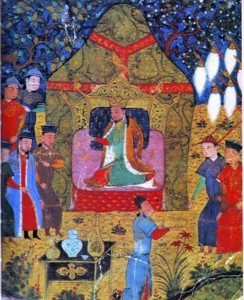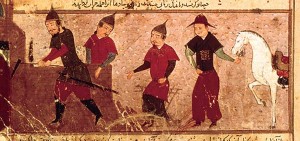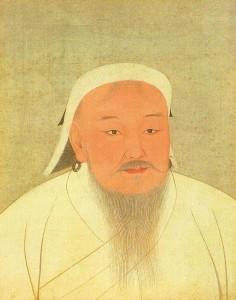Genghis Khan (1162-1227) was the first ruler of the Mongol Empire, uniting a number of nomadic tribes to create an enormous empire. He was known for his ferocity in warfare, sometimes putting whole populations of conquered lands to the sword. However, he also supported the cultural development of the peoples he ruled, allowing relatively free religious observance and encouraging the introduction of written scripts. Today, he is considered Mongolia’s founding father.
Early Life
Although 1162 is the typical accepted date for Genghis Khan’s birth, the records for this period are few in number. Many claims of his birth include a variety of dates between 1155 and 1165. His birth name was Temujin, and he was the son of Yesukhei, who ruled a small clan of nomad hunters, the Borijin. His mother, Hoelun, had been kidnapped from another marriage by Temujin. The baby is said to have had a blood clot on his fist at his birth. This is traditionally considered a sign of his destiny as a warrior.
When the child was nine, he was taken by his father to a nearby tribe so that he might learn to work and find a wife. He was betrothed to Borje, a girl who was slightly older than he was, but as they were returning home, his father was killed when he was poisoned by rebels. The young Temujin went to live with his mother, but Yesukhei’s two widows and seven children were cast out by the clan and left to die.
What remained of his family was now on the edge of starvation, and they were reduced to eating not only fish but rodents and roots in order to survive at all. Temujin and his brother, Khasar, started to resent Begter, a half-brother, (for reasons that are now obscure) and killed him. As a punishment for this great crime, Temujin was condemned to slavery, a situation which may have persisted for as long as five years.
Early Adult Life
By the time he was 16, Temujin was once again a free man and went to look for Borje. Finding to his delight that she was still willing to accept him, the pair quickly married. The sable coat that was given as a dowry was used to ally with Ong Khan, who led the Kereyids, a powerful tribe. Ong Khan was willing to take the young Temujin under his protection as a foster son.
The importance of this alliance was shown when a Merkid clan, from which Hoelun had originally come, plotted to avenge her earlier kidnap by capturing Borje. In response, Temujin and the army of the Kereyids mounted a raid on the Merkids, rescuing Borje and carrying away a decent amount of loot. A member of this raiding party was Jamuka, a Temujin’s blood-brother from childhood. Nine months later, Borje gave birth to her first son, Jochi.
After the successful rescue mission, Temujin and his men remained with Jamuka for a number of years. The latter, however, rather than reciprocating his friendship as a blood-brother might, insisted on asserting his authority. Eventually, a feud grew between the two young men that would last twenty years. Temujin left the encampment, and a number of the followers of Jamuka did likewise, taking some livestock.
Rise to Power
 When he was 27, Temujin held a kuriltai, a political and military council of Mongol chiefs. He was proclaimed a khan, but since the Mongols at this stage were no more than a sub-division of the Kereyids, it was simple for Ong Khan to maintain his own position by skillfully exploiting the tensions between Temujin and Jamuka.
When he was 27, Temujin held a kuriltai, a political and military council of Mongol chiefs. He was proclaimed a khan, but since the Mongols at this stage were no more than a sub-division of the Kereyids, it was simple for Ong Khan to maintain his own position by skillfully exploiting the tensions between Temujin and Jamuka.
Now that he was khan, Temujin showered his family and those who had shown loyalty with rewards of high office. However, in 1190 he suffered a grievous blow: Jamuka mounted a raid on his camp. He treated those he captured with great brutality, sometimes even going so far as boiling them alive. This cruelty disgusted even some of his own followers, who joined Temujin instead.
The newly united Mongols succeeded in making quick victories over the Jurchens and Tatars of neighboring areas. It had previously been the custom that such conquered lands would be looted and then abandoned, but Temujin Khan decided to assimilate their people into his own empire instead. In 1201, he and Ong Khan suffered an attack by Jamuka’s forces. Temujin was wounded when he was struck in the neck by an arrow, but he overcame this setback to win the battle, eventually bringing the opposing warriors under his sway.
Treachery and Conquest
 Despite having fought alongside him against Jamuka, Ong Khan set up an ambush for Temujin at a ceremony to mark the wedding of Jochi and Ong’s daughter. The Mongols evaded the ambush while returning the favor and conquered the Kereyids.
Despite having fought alongside him against Jamuka, Ong Khan set up an ambush for Temujin at a ceremony to mark the wedding of Jochi and Ong’s daughter. The Mongols evaded the ambush while returning the favor and conquered the Kereyids.
By 1204, the unification of Mongolia was complete with the defeat of the dangerous Naiman clan. In 1206, a second kuriltai gave Temujin the title of Genghis Khan, proclaiming him the leader of the unified Mongolia.
By 1211, large tracts of Siberia and Xinjiang, now part of China, were annexed by the Mongols. These actions came to the notice of the Jurched Dynasty, which ruled much of northern China. From its capital in Zhongdu (now Beijing) the dynasty’s leader gave an ultimatum to Genghis: that he must bow before the Golden Khan of the Jurcheds. Genghis responded by simply spitting on the ground.
He continued his aggressive response with the military defeat of the Tangut, a Jurched tributary. By 1214, the 50 million subjects of the Jurched Dynasty fell under his reign despite the fact that the Mongols had an army of only 100,000. Genghis Khan was now the ruler of a huge empire, but he was still not satisfied.
Further Military Advance
Buddhist tribes in distant lands such as Kazakhstan, having heard tales of the Great Khan, overthrew their leaders and swore fealty to Genghis’s empire. By 1219, the lands that he ruled stretched as far as the borders of Afghanistan and Tibet.
Genghis attempted to make a trading alliance with the Kwarizm Empire of central Asia. The empire’s ruler, Sultan Muhammad II, reneged on the agreement and slaughtered an entire Mongol trade caravan, plundering its treasures. Genghis Khan became furious, swearing that the Sultan would suffer a terrible revenge. Before the year was out, he had taken every single city of the Kwarizm Empire. For good measure, he also added Russian and Turkish lands to his empire.
His Later Life and Eventual Death
By now Genghis Khan was about sixty years old, and in 1222 he called a kuriltai among his family members, with the intention of securing an orderly succession. His four sons could not agree on who would inherit the title of Great Khan: although Jochi was the eldest, his birth soon after the kidnap of Borje meant that his father’s identity was uncertain.
Chagatai, the second son, challenged him, but Ogodei, the third son, was eventually accepted as a compromise candidate. In February 1227, Jochi died. Six months later, Genghis Khan himself also came to the end of his long and eventful life. The vast empire he had built up was split between his three remaining sons and Jochi’s own two sons.
